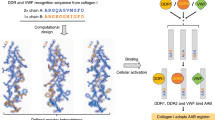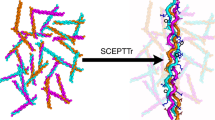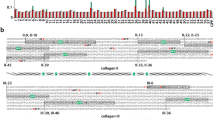Abstract
The nature of the supramolecular complex between fibrillar collagen and collagen-binding proteins (CBPs) has hindered detailed X-ray and NMR analyses of the ligand-recognition mechanism at atomic resolution because of the lack of appropriate approaches for studying large heterogeneous supramolecular complexes. Recently, we proposed an NMR method, termed transferred cross-saturation (TCS), that enables the rigorous identification of contact residues in a huge protein complex. Here we used TCS to study the supramolecular complex between the A3 domain of von Willebrand factor and fibrillar collagen, which allowed the successful determination of the ligand-binding site of the A3 domain. The binding site of the A3 domain was located at its hydrophobic 'front' surface and was completely different from that of the I domain from the a2 subunit of integrin (α2-I domain), which was reported to be the hydrophilic 'top' surface of α2-I, although the A3 domain and the α2-I domain share a similar fold and possess the identical function of collagen binding.
This is a preview of subscription content, access via your institution
Access options
Subscribe to this journal
Receive 12 print issues and online access
$189.00 per year
only $15.75 per issue
Buy this article
- Purchase on Springer Link
- Instant access to full article PDF
Prices may be subject to local taxes which are calculated during checkout




Similar content being viewed by others
References
Kadler, K.E., Holmes, D.F., Trotter, J.A. & Chapman, J.A. Collagen fibril formation. Biochem. J. 316, 1–11 (1996).
Juliano, R.L. & Haskill, S. Signal transduction from the extracellular matrix. J. Cell. Biol. 120, 577–585 (1993).
Foster, T.J. & Hook, M. Surface protein adhesins of Staphylococcus aureus. Trends Microbiol. 6, 484–488 (1998).
Colombatti, A. & Bonaldo, P. The superfamily of proteins with von Willebrand factor type A-like domains: one theme common to components of extracellular matrix, hemostasis, cellular adhesion, and defense mechanisms. Blood 77, 2305–2315 (1991).
Perkins, S.J. et al. The secondary structure of the von Willebrand factor type A domain in factor B of human complement by Fourier transform infrared spectroscopy. J. Mol. Biol. 238, 104–119 (1994).
Emsley, J., Knight, C.G., Farndale, R.W., Barnes, M.J. & Liddington, R.C. Structural basis of collagen recognition by integrin α2β1. Cell 101, 47–56 (2000).
Dickeson, S.K. & Santoro, S.A. Ligand recognition by the I domain-containing integrins. Cell. Mol. Life Sci. 54, 556–566 (1998).
Ruggeri, Z.M. von Willebrand factor. J. Clin. Invest. 99, 559–564 (1997).
Cruz, M.A., Yuan, H., Lee, J.R., Wise, R.J. & Handin, R.I. Interaction of the von Willebrand factor (vWF) with collagen. J. Biol. Chem. 270, 10822–10827 (1995).
Lankhof, H. et al. A3 domain is essential for interaction of von Willebrand factor with collagen type III. Thromb. Haemost. 75, 950–958 (1996).
Bienkowska, J., Cruz, M., Atiemo, A., Handin, R. & Liddington, R. The von Willebrand factor A3 domain does not contain a metal ion-dependent adhesion site motif. J. Biol. Chem. 272, 25162–25167 (1997).
Huizinga, E.G., van der Plas, R.M., Kroon, J., Sixma, J.J. & Gros, P. Crystal structure of the A3 domain of human von Willebrand factor: implications for collagen binding. Structure 5, 1147–1156 (1997).
van der Plas, R.M. et al. Binding of von Willebrand factor to collagen type III: role of specific amino acids in the collagen binding domain of vWF and effects of neighboring domains. Thromb. Haemost. 84, 1005–1011 (2000).
Romijn, R.A. et al. Identification of the collagen-binding site of the von Willebrand factor A3-domain. J. Biol. Chem. 276, 9985–9991 (2001).
Takahashi, H., Nakanishi, T., Kami, K., Arata, Y. & Shimada, I. A novel NMR method for determining the interfaces of large protein–protein complexes. Nat. Struct. Biol. 7, 220–223 (2000).
Nakanishi, T. et al. Determination of the interface of a large protein complex by transferred cross-saturation measurements. J. Mol. Biol. 318, 245–249 (2002).
Jayalakshmi, V. & Krishna, N.R. Complete relaxation and conformational exchange matrix (CORCEMA) analysis of intermolecular saturation transfer effects in reversibly forming ligand-receptor complexes. J. Magn. Reson. 155, 106–118 (2002).
Nishida, N. et al. Backbone 1H, 13C, 15N resonance assignments of the von Willebrand factor A3 domain. J. Biomol. NMR in the press (2002).
Ribba, A.S. et al. Ser968Thr mutation within the A3 domain of von Willebrand factor (vWF) in two related patients leads to a defective binding of VWF to collagen. Thromb. Haemost. 86, 848–854 (2001).
Verkleij, M.W. et al. Adhesive domains in the collagen III fragment α1(III)CB4 that support α2β1- and von Willebrand factor–mediated platelet adhesion under flow conditions. Thromb. Haemost. 82, 1137–1144 (1999).
Knight, C.G. et al. The collagen-binding A-domains of integrins α1β1 and α2β1 recognize the same specific amino acid sequence, GFOGER, in native (triple-helical) collagens. J. Biol. Chem. 275, 35–40 (2000).
Chen, J.M., Kung, C.E., Feairheller, S.H. & Brown, E.M. An energetic evaluation of a 'Smith' collagen microfibril model. J. Protein Chem. 10, 535–552 (1991).
Tuckwell, D. Evolution of von Willebrand factor A (VWA) domains. Biochem. Soc. Trans. 27, 835–840 (1999).
Clore, G.M. & Gronenborn, A.M. Multidimensional heteronuclear nuclear magnetic resonance of proteins. Methods Enzymol. 239, 349–363 (1994).
Delaglio, F. et al. NMRPipe: a multidimensional spectral processing system based on UNIX pipes. J. Biomol. NMR 6, 277–293 (1995).
Kraulis, P.J. ANSIG: a program for the assignment of protein 1H 2D NMR spectra by interactive computer graphics. J. Mol. Biol. 184, 627–633 (1989).
Mori, S. et al. Improved sensitivity of HSQC spectra of exchanging protons at short interscan delay using a new fast HSQC (FHSQC) detection scheme that avoids water saturation. J. Magn. Reson. B 108, 94–98 (1995).
Kupce, E. & Wagner, G. Wideband homonuclear decoupling in protein spectra. J. Magn. Reson. B 109, 329–333 (1995).
Sasaki, T. et al. Limited cleavage of extracellular matrix protein BM-40 by matrix metalloproteinases increases its affinity for collagens. J. Biol. Chem. 272, 9237–9243 (1997).
Palma, P.N., Krippahl, L., Wampler, J.E. & Moura, J.J. BiGGER: a new (soft) docking algorithm for predicting protein interactions. Proteins 39, 372–384 (2000).
Kraulis, P. MOLSCRIPT: a program to produce both detailed and schematic plots of protein structures. J. Appl. Crystallogr. 24, 924–950 (1991).
Merritt, E.A. & Bacon, D.J. Raster3D: photorealistic molecular graphics. Methods Enzymol. 277, 505–524 (1997).
Acknowledgements
I.S. thanks G. Wagner and M. Ikura for useful discussions. This work was supported by a grant from the Japan New Energy and Industrial Technology Development Organization (NEDO).
Author information
Authors and Affiliations
Corresponding author
Ethics declarations
Competing interests
The authors declare no competing financial interests.
Rights and permissions
About this article
Cite this article
Nishida, N., Sumikawa, H., Sakakura, M. et al. Collagen-binding mode of vWF-A3 domain determined by a transferred cross-saturation experiment. Nat Struct Mol Biol 10, 53–58 (2003). https://doi.org/10.1038/nsb876
Received:
Accepted:
Published:
Issue Date:
DOI: https://doi.org/10.1038/nsb876
This article is cited by
-
Recombinant mussel proximal thread matrix protein promotes osteoblast cell adhesion and proliferation
BMC Biotechnology (2016)
-
Interaction of the α2A domain of integrin with small collagen fragments
Protein & Cell (2010)
-
Structural basis of the collagen-binding mode of discoidin domain receptor 2
The EMBO Journal (2007)
-
Experimental schistosomiasis, protective aspects of granulomatous reaction in the mouse liver
Parasitology Research (2005)



